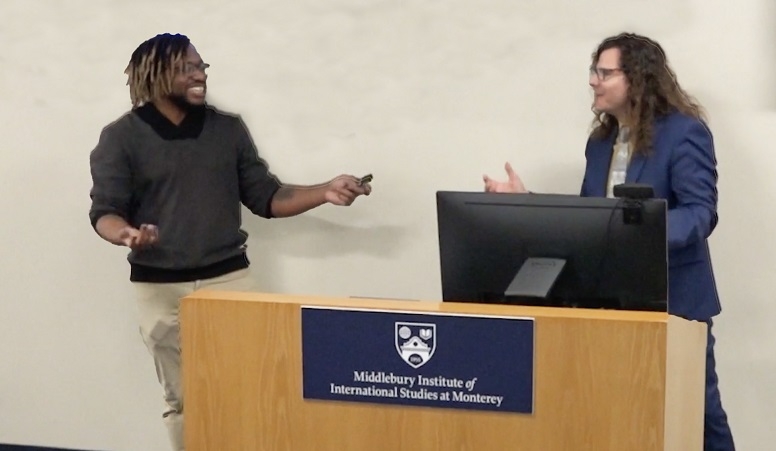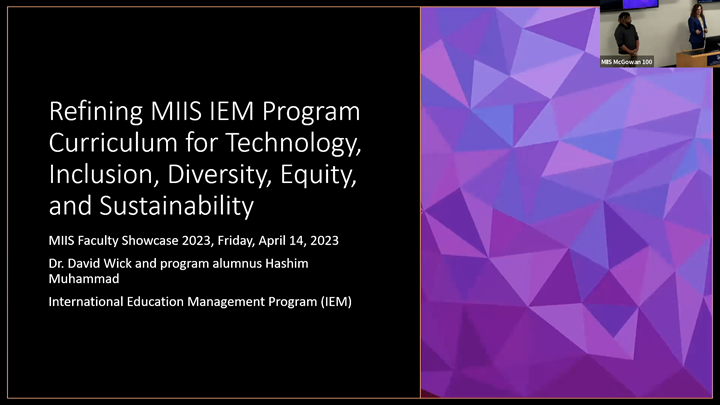For This Audit, Students Graded Their Professors

A pandemic. A global reckoning on race and colonialism. Unprecedented technological advances.
A lot has changed since the Institute launched its International Education Management (IEM) program in 2012.
“International educational exchange has always been an exclusive practice. At the same time, global learning experiences can promote equity and justice in powerful ways,” said David Wick, one of the four full-time faculty in the program. “Despite decades of scholarship and practice work to advance diversity and inclusion in international education, there has been little change. As a faculty, we recognized that we had to prepare our students to lead equitable, inclusive, and sustainable change in the field.”
Faculty in the program leaned into the process, thinking about how to make their courses more representative and inclusive; imagining how they could leverage technology and make the program sustainable.
For answers, they turned not to external consultants, but to their own students.
“Our students come with a lot of knowledge, skill, and experience,” said Wick. “We always seek to include funded student researchers on department projects and have always found it beneficial for students to see ways that they will be part of a program and the kinds of collaboration that can happen.”
With funding from the Provost’s Office, they set up an audit of their current program called “Changing TIDES—Technology, Inclusion, Diversity, Equity, and Sustainability.”
Four students have completed audits of 17 core and elective courses. The four then graduate student auditors published the results of “Changing TIDES” alongside their professors in Diversity Abroad’s Global Impact Exchange (Read the article).
To launch their research, each of the students was paired with a faculty member. Wick was paired with Hashim Muhammad MAIEM ’22, who took Wick’s Design and Assessment Project courses, then used a rubric to complete a detailed review and make recommendations. Muhammad came to the Institute after completing his BA at Ohio State, teaching through the English Program in Korea (EPIK 2019), and completing Peace Corps work (Armenia 2020).
Despite his experience, it wasn’t easy to approach renowned experts in the field with suggestions for improvement.
“Anyone with humility would say that it’s hard to go into that circumstance and be like ‘Hey, you should do this, or this doesn’t work,’” said Muhammad. “That’s just a natural power dynamic that exists there.”
Grounded in a Rubric and Relationships
There were a few key elements to making the process work.
The first was using Middlebury’s Digital Learning and Inquiry rubric (DLINQ) to ground the audit. During this period, the faculty were redesigning their fully in-person program to create a new Online Master of Arts in International Education Management, which launched in fall 2022.
“In a way, all learning is digital learning now,” said Wick.
“We could ground the conversations, saying, ‘According to the rubric that we’re all agreed on, your classes may be missing these points,’” Muhammad said.
Secondly, the auditors were assigned to review courses they had already completed themselves.
“Having that relationship established in class made me very comfortable talking to David Wick. I knew what kind of person he was. He’s not going to be one to shut me out. And that goes for all of our teachers.”
David Wick and Hashim Muhammad MAIEM ’22 presented together about the project at the Spring 2023 Faculty Showcase
How Curriculum and Pedagogy Shifted through the Process
The global push for equitable treatment of people of all identities brought the need for change to the doorstep of the international education field.
“To be honest, in the field, there’s just a bunch of white faces,” Muhammad said. “Most of my teachers were white. In the rare classes where we had someone who wasn’t, I was actually really excited about seeing someone who shared some of my identities, but also seeing that I’m not going into a field where it’s just a sea of white.”
He attended a Black, Indigenous, People of Color (BIPOC) focus group at the NAFSA: Association of International Educators Conference, where he was energized hearing about different creative initiatives around this.
“How can we sit back and stay stagnant?” he said. “We can’t. I think this kind of work is just the responsible thing to do as an educator.”
The audit included looking at the diversity of authors for readings assigned in each course.
“No faculty members, regardless of their identities, will ever be able to see from—or present—all possible perspectives,” said Wick.
After the TIDES process, he shifted how he assigns readings. Instead of one common reading, he now often asks students to choose from various options in order to create a multivoiced conversation privileging nonwhite and nonglobal north voices. He sometimes has students seek out texts around a key question. These students’ sources could then become part of the reading list for future iterations of the class, a process Wick labeled “self-refreshing.”
“It’s changing both the stuff we’re looking at and changing how we look at any source,” said Wick.
Auditors also flagged the importance of captioning and transcription for videos. They noted that many instructors always had captions, but what about submitted student-made media? And how can students be assured that their video won’t be shared outside of the classroom community? Many issues like this have required changes to individual course policies, but have also prompted engagement with administrators and staff to address changes at the institutional level.
The S in TIDES stands for sustainability, one of the more challenging areas to tackle—even to define. For example, it could refer to the carbon footprint of study abroad or to student well-being and burnout, which was top of mind for Muhammad.
“I think students need to be supported; minorities, especially, should be extra supported, inside and outside the classroom. It’s not just about getting information into people’s heads, it’s not just about developing technical skills, it’s about taking care of students holistically,” said Muhammad.
In one of Wick’s courses, Muhammad flagged that he felt overloaded by the number of assignments—something only a former student in the class could speak to.
“It’s making sure that when students are learning, they are doing it comfortably because that’s how your brain works; it learns better when it’s relaxed and not when it’s stressed out,” he said. The sentiment harkens back to his practicum days in Costa Rica when he was responsible for the mental and emotional well-being of U.S. study abroad students. He applies this lens also to his current job teaching professional development skills to Latinx youth.
A Replicable Model
But would this audit model only work for students who are training as educators themselves?
Both Wick and Muhammad said no.
“The process and the primary analytical tool, the DLINQ rubric, are written in plain language, so any student from any program has the analytical skills to answer—yes or no—did the teacher do x, y, and z explicitly,” said Wick.
They hope more programs will leverage the model.
“I feel like it could be useful for anyone looking to improve their curriculum and their teaching methods. There’s always room for improvement,” Muhammad said. “Instructors should be coming from a place of empathy and compassion.”

